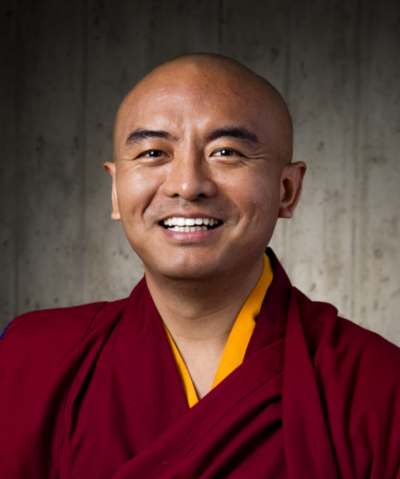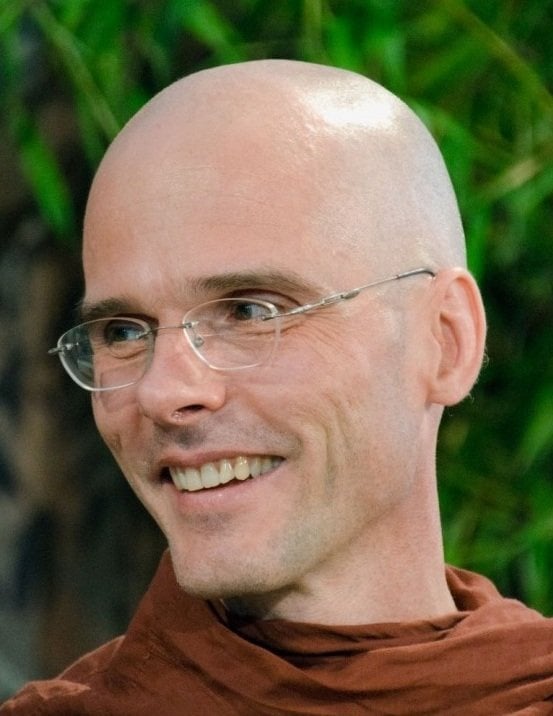Yongey Mingyur Rinpoche and Venerable Bhikkhu Anālayo engage in a brilliant dialogue on the intersection of Mahāmudrā and Early Buddhism.
About this Course
In this groundbreaking course, Yongey Mingyur Rinpoche and Venerable Bhikkhu Anālayo will take you on a profound exploration of meditation through the lenses of Mahāmudrā and early Buddhism. This is a truly exceptional opportunity to receive teachings from two beloved teachers as they provide heart teachings, discuss together, and guide you in your practice.
Yongey Mingyur Rinpoche and Venerable Anālayo discuss common practice elements such as emptiness, selflessness, and signlessness, and concepts of objectless meditation in their respective traditions while also discussing the role of compassion, and much more. Readings provide articles and translations of important suttas by Venerable Anālayo including The Shorter Discourse on Emptiness and The Satipaṭṭhāna Sutta, as well as readings from Dakpo Tashi Namgyal’s influential text Mahāmudrā—The Moonlight, Mahāmudrā—A Practical Guide, and more.
What you’ll learn about
- meditation on the dissolving of the elements and letting go of the solidity of experience;
- the Mahāmudrā perspective of the mind;
- how the mind recognizes identities and labels;
- how the mind can rest in the state of emptiness;
- techniques to bring meditation into everyday life;
- and much more.
(Note: subtitles for course videos are automatically generated and may not be accurate.)
Lessons
Lesson 1: How the Buddha Might Have Meditated
In this unique introductory lesson, Yongey Mingyur Rinpoche and Venerable Bhikkhu Anālayo explore the intersections between Mahāmudrā and Early Buddhism. In discussing how the Buddha Shakyamuni might have meditated, Mingyur Rinpoche and Venerable Anālayo compare common elements of practice such as emptiness, selflessness, and signlessness.
In this unique introductory lesson, Yongey Mingyur Rinpoche and Venerable Bhikkhu Anālayo explore the intersections between Mahāmudrā and Early Buddhism. In discussing how the Buddha Shakyamuni might have meditated, Mingyur Rinpoche and Venerable Anālayo compare common elements of practice such as emptiness, selflessness, and signlessness.
Lesson 2: Introduction to Meditation in Early Buddhism
Venerable Anālayo begins with a lecture and meditation exploring The Shorter Discourse on Emptiness, looking at the universality of the practice of abiding in emptiness throughout Buddhist traditions. Focusing on the four establishments of mindfulness, Venerable Anālayo guides a meditation through the dissolving of the elements and letting go of the solidity of experience.
Venerable Anālayo begins with a lecture and meditation exploring The Shorter Discourse on Emptiness, looking at the universality of the practice of abiding in emptiness throughout Buddhist traditions. Focusing on the four establishments of mindfulness, Venerable Anālayo guides a meditation through the dissolving of the elements and letting go of the solidity of experience.
Lesson 3: View—Breath as a Support for Awareness
Mingyur Rinpoche explores the Mahāmudrā perspective of the mind and its emptiness, emphasizing the crucial nature of the experiential aspect of awareness of the mind to the Mahāmudrā path. Using the breath, awareness can gently be established without grasping or controlling, leading to progress in realizations of all four Noble Truths.
Mingyur Rinpoche explores the Mahāmudrā perspective of the mind and its emptiness, emphasizing the crucial nature of the experiential aspect of awareness of the mind to the Mahāmudrā path. Using the breath, awareness can gently be established without grasping or controlling, leading to progress in realizations of all four Noble Truths.
Lesson 4: Recognizing Selflessness
Venerable Anālayo goes further into the practice of emptiness, turning attention to the self. By shifting our attention, the pervasive power of feelings, perceptions, contact, and intentions can be loosened and the mind can begin to know itself.
Venerable Anālayo goes further into the practice of emptiness, turning attention to the self. By shifting our attention, the pervasive power of feelings, perceptions, contact, and intentions can be loosened and the mind can begin to know itself.
Lesson 5: Meditation and the Luminous Mind
Like gravity, the true nature of awareness is ever-present in our experience and can be sensed at any time, Mingyur Rinpoche explains. Recognizing awareness, the clear and knowing, self-luminous aspect of the mind provides the fundamental basis for Mahāmudrā practice. Abiding in that state constitutes a basis for śamatha, while investigation of the subjects that arise to awareness constitutes a basis for vipaśyanā.
Like gravity, the true nature of awareness is ever-present in our experience and can be sensed at any time, Mingyur Rinpoche explains. Recognizing awareness, the clear and knowing, self-luminous aspect of the mind provides the fundamental basis for Mahāmudrā practice. Abiding in that state constitutes a basis for śamatha, while investigation of the subjects that arise to awareness constitutes a basis for vipaśyanā.
Lesson 6: The Path of Signlessness
Venerable Anālayo provides teachings on identifying signs and signlessess, illustrating how the mind recognizes identities and labels. Venerable Anālayo explains the experience of the signless and that which knows takes on an infinite character, the appropriation of experience is lessened, and the mind can rest in the state of emptiness.
Venerable Anālayo provides teachings on identifying signs and signlessess, illustrating how the mind recognizes identities and labels. Venerable Anālayo explains the experience of the signless and that which knows takes on an infinite character, the appropriation of experience is lessened, and the mind can rest in the state of emptiness.
Lesson 7: Conduct—Dharma and Daily Life
Mingyur Rinpoche gives final instructions on traversing the path of emptiness, looking at how to apply these transformative teachings to everyday life. Rinpoche provides examples of deconstruction techniques and methods to transform everyday awareness into the path, enriching life with wisdom and compassion.
Mingyur Rinpoche gives final instructions on traversing the path of emptiness, looking at how to apply these transformative teachings to everyday life. Rinpoche provides examples of deconstruction techniques and methods to transform everyday awareness into the path, enriching life with wisdom and compassion.
About the Teachers
 Yongey Mingyur Rinpoche was born in the Himalayan border regions between Tibet and Nepal. A rising star among the new generation of Tibetan Buddhist masters, Rinpoche's candid, often humorous accounts of his personal difficulties have endeared him to audiences around the world. Rinpoche is the author of two bestselling books and oversees the Tergar Meditation Community, an international network of Buddhist meditation centers.
He is the son of the renowned meditation master Tulku Urgyen Rinpoche and was formally enthroned as the seventh incarnation of Yongey Mingyur Rinpoche by Tai Situ Rinpoche when he was twelve years old. When he was twenty years old, Rinpoche was appointed as the functioning abbot of Sherab Ling Monastery. In addition to his extensive background in meditation and Buddhist philosophy, Mingyur Rinpoche has held a lifelong interest in psychology, physics, and neurology. He teaches regularly throughout Europe, North and South America, and Asia.
Yongey Mingyur Rinpoche was born in the Himalayan border regions between Tibet and Nepal. A rising star among the new generation of Tibetan Buddhist masters, Rinpoche's candid, often humorous accounts of his personal difficulties have endeared him to audiences around the world. Rinpoche is the author of two bestselling books and oversees the Tergar Meditation Community, an international network of Buddhist meditation centers.
He is the son of the renowned meditation master Tulku Urgyen Rinpoche and was formally enthroned as the seventh incarnation of Yongey Mingyur Rinpoche by Tai Situ Rinpoche when he was twelve years old. When he was twenty years old, Rinpoche was appointed as the functioning abbot of Sherab Ling Monastery. In addition to his extensive background in meditation and Buddhist philosophy, Mingyur Rinpoche has held a lifelong interest in psychology, physics, and neurology. He teaches regularly throughout Europe, North and South America, and Asia. Bhikkhu Anālayo is a scholar-monk and the author of numerous books on meditation and early Buddhism, such as Satipatthāna: The Direct Path to Realization, Perspectives on Satipatthāna, and Satipatthāna Meditation: A Practice Guide. His main area of academic research is early Buddhism, with a special interest in the topics of meditation and women in Buddhism.
Bhikkhu Anālayo was born in Germany in 1962 and ordained in Sri Lanka in 1995. In the year 2000 he completed a PhD thesis on the Satipaṭṭhāna-sutta at the University of Peradeniya (published by Windhorse in the UK). In the year 2007 he completed a Habilitation research at the University of Marburg, in which he compared the Majjhima-nikāya discourses with their Chinese, Sanskrit, and Tibetan counterparts. Besides his academic activities, he regularly teaches meditation.
Bhikkhu Anālayo is a scholar-monk and the author of numerous books on meditation and early Buddhism, such as Satipatthāna: The Direct Path to Realization, Perspectives on Satipatthāna, and Satipatthāna Meditation: A Practice Guide. His main area of academic research is early Buddhism, with a special interest in the topics of meditation and women in Buddhism.
Bhikkhu Anālayo was born in Germany in 1962 and ordained in Sri Lanka in 1995. In the year 2000 he completed a PhD thesis on the Satipaṭṭhāna-sutta at the University of Peradeniya (published by Windhorse in the UK). In the year 2007 he completed a Habilitation research at the University of Marburg, in which he compared the Majjhima-nikāya discourses with their Chinese, Sanskrit, and Tibetan counterparts. Besides his academic activities, he regularly teaches meditation.$397.00Enroll
